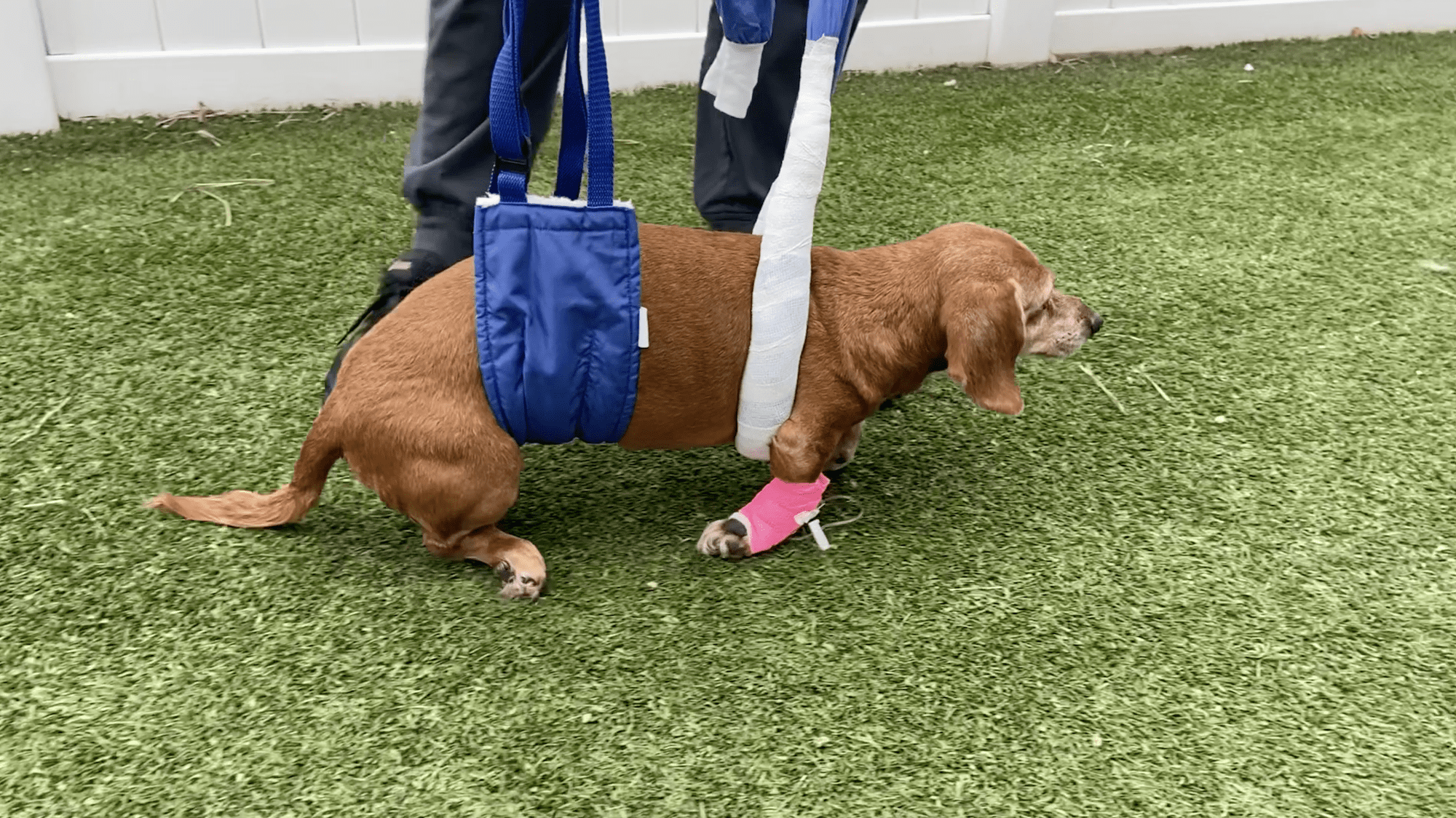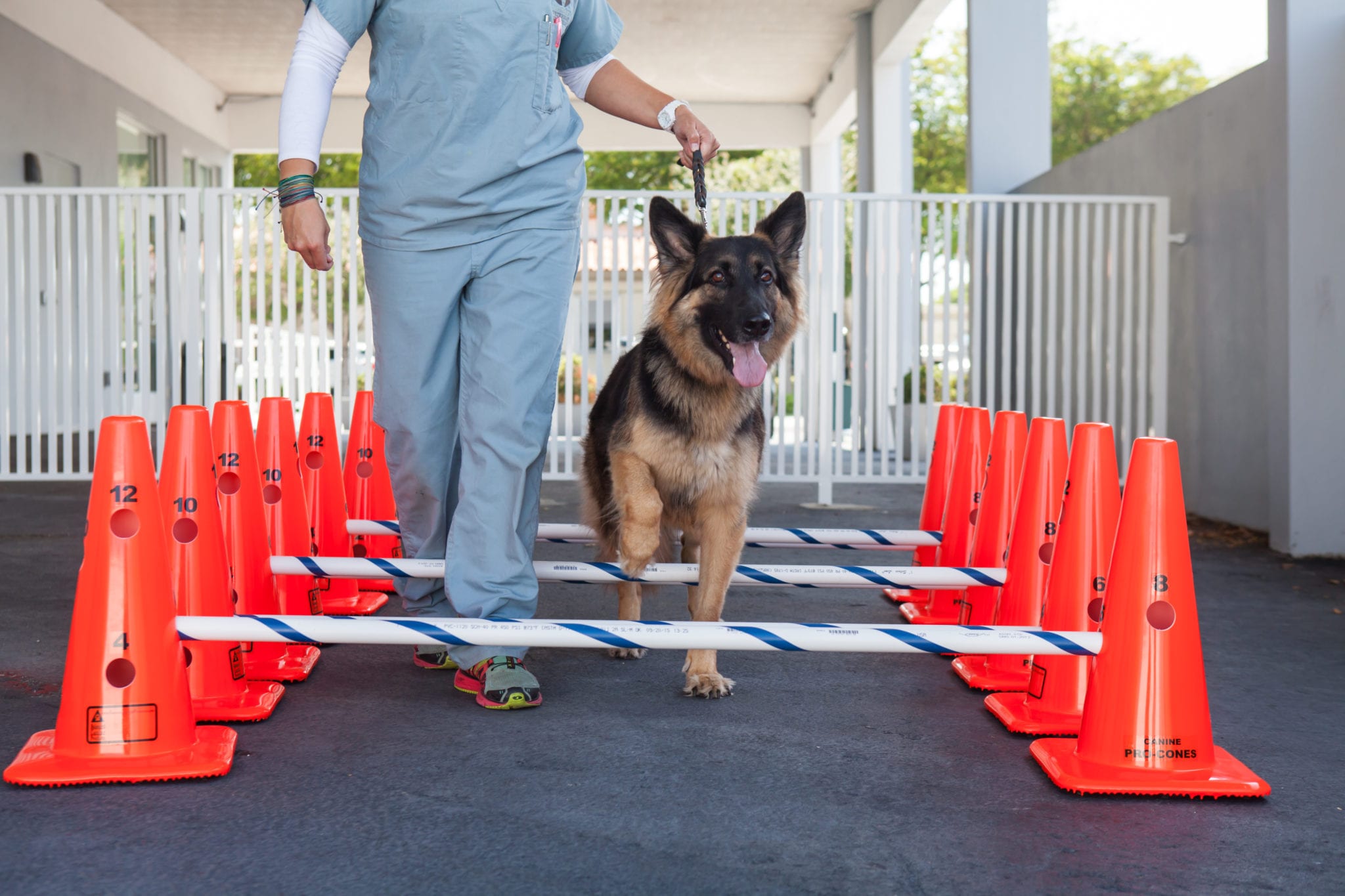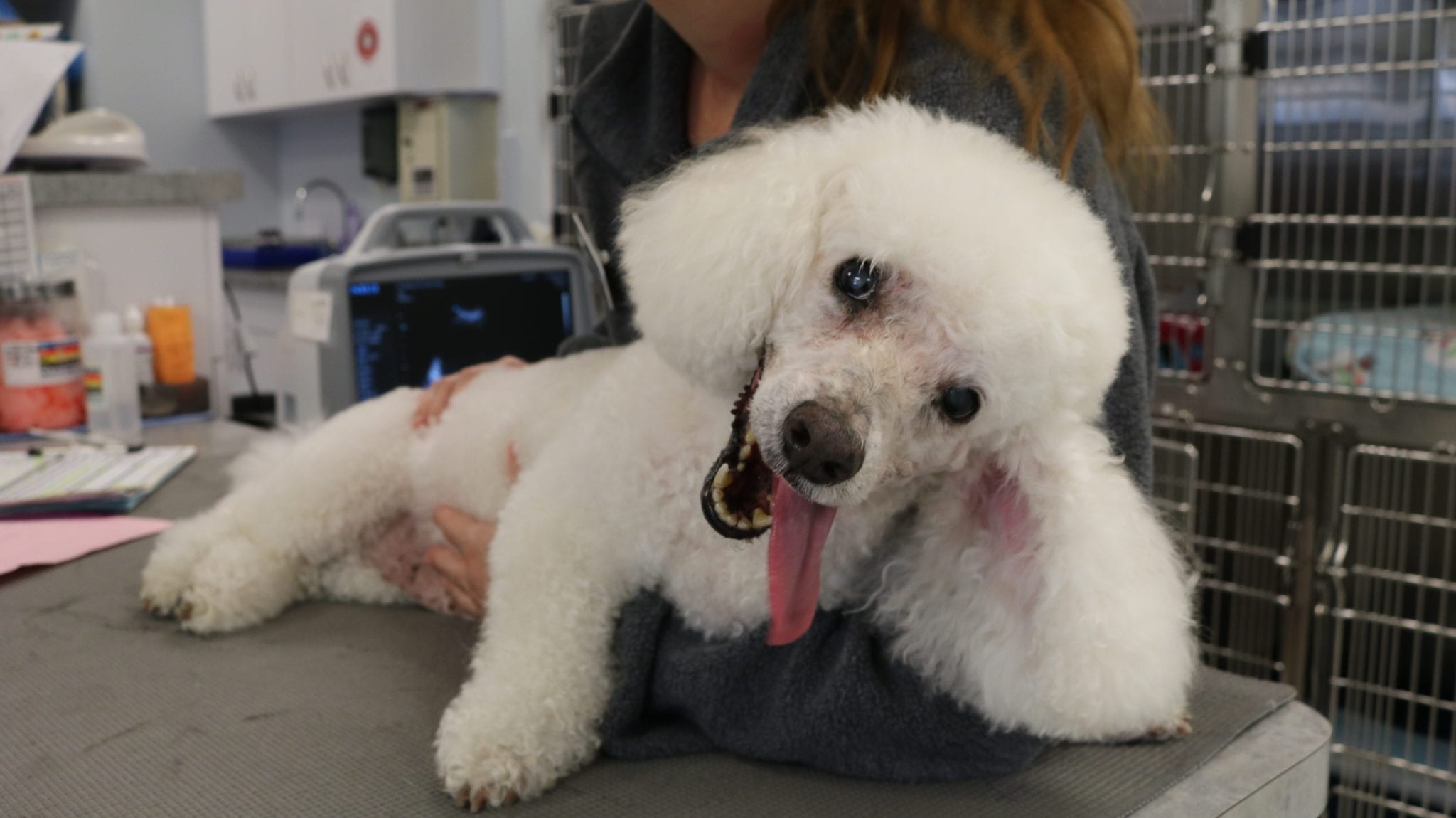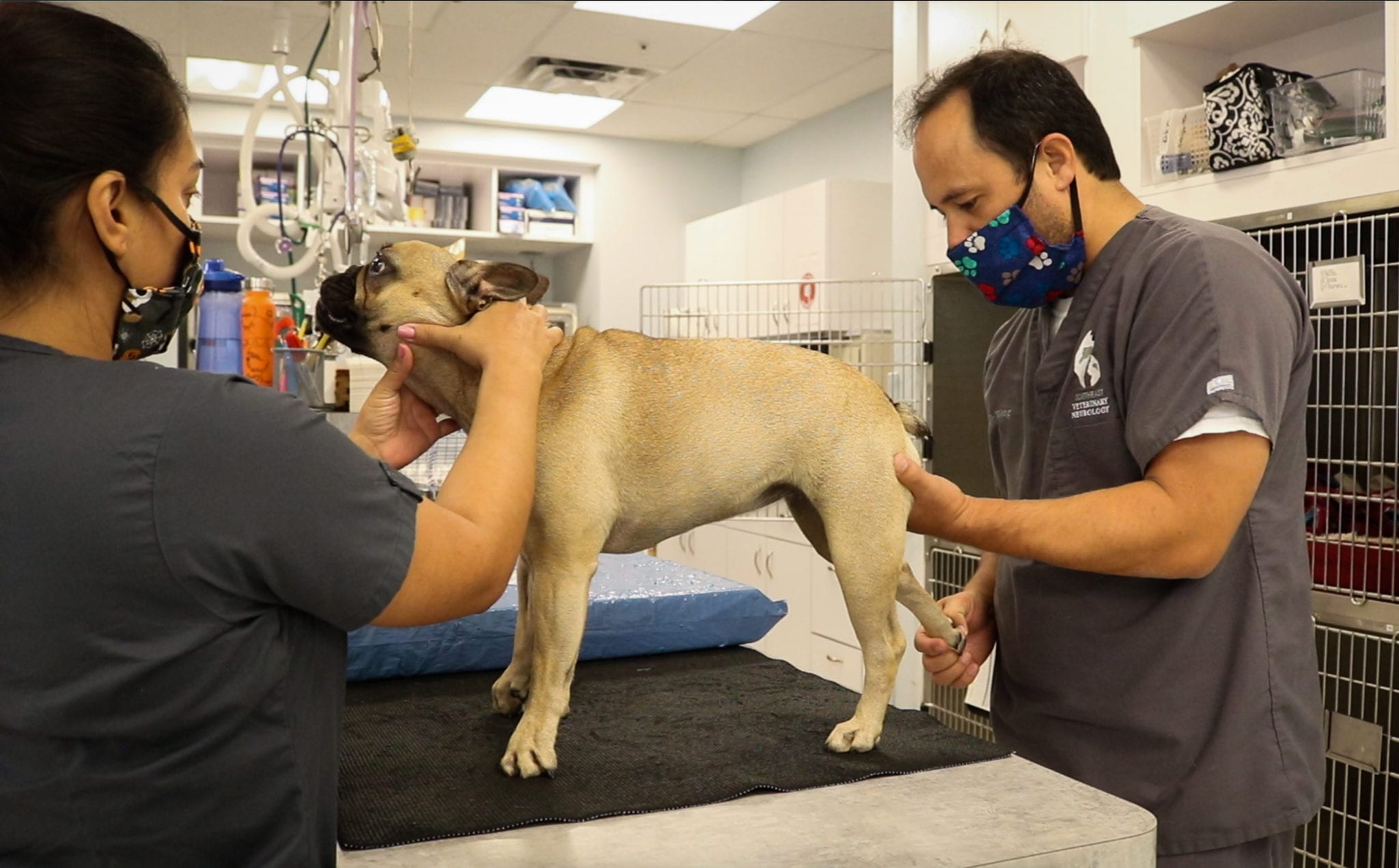There are many possible reasons why a dog can’t stand up, ranging from toxicity, injuries, and orthopedic reasons to infections, illnesses, and cardiovascular reasons. Here, we will take a look at five neurological reasons for your dog’s sudden inability to stand.

5 Neurological Reasons Your Dog Can’t Stand Up
As veterinary neurologists, one of the most common cases we treat is a dog that can’t stand up. These are the most likely causes.
Slipped Disc
Intervertebral Disc Disease (IVDD) is one of the most common conditions seen in veterinary neurology and the most common spinal cord condition in dogs. Also known as slipped, bulging, herniated, or ruptured disc, IVDD occurs when the shock-absorbing discs between spinal vertebrae deteriorate.
Chondrodystrophic (short legged) breeds, such as Dachshunds, French Bulldogs, and Shih Tzus, are the most highly predisposed, but it can occur in any dog.
IVDD is treated either medically or surgically depending on its severity, and dogs can absolutely recover. However, IVDD can cause permanent damage without timely treatment, so please don’t wait to visit a veterinarian if your dog can’t stand up.
Other signs your dog might have IVDD:
- Shivering, shaking, or muscle spasms
- Whining when moved or touched
- Loss of appetite
- Incontinence
Fibrocartilaginous Embolism (FCE)
FCE happens when a piece of fibrocartilage (connective tissue) from an intervertebral disc makes its way into the bloodstream and blocks blood flow to the spinal cord.
Mostly seen in giant and large breed dogs, the symptoms come on suddenly during activity. The dog will typically cry out at the time, but the condition does not remain painful.
The good news is that your dog can heal from FCE with physical therapy alone, and the prognosis is excellent. The bad news is that other spinal cord conditions can look like FCE, but require very different approaches. Therefore, an accurate diagnosis is imperative if your dog can’t stand up.
More signs of FCE in dogs:
- Dog cries out while being active, but is not painful after the initial injury
- Sudden weakness after activity, usually on one side of the body
- Signs do not worsen after the first few hours

Atlantoaxial (AA) Luxation
AA Luxation in dogs is a spinal disorder where there is excessive movement between the first two bones in the neck. Since it affects the spinal cord and bones of the neck, symptoms usually affect all four limbs.
It is most often seen as a congenital (present at birth) malformation in toy breeds like Yorkies, Malteses, Chihuahuas, and Toy Poodles under a year old, but it is possible for any dog to be affected by a similar injury acquired secondary to trauma.
In severe cases, AA luxation can be fatal due to paralysis of the diaphragm, so please see a veterinarian as soon as possible if your dog can’t stand up. Surgery at Southeast Veterinary Neurology has a greater than 90% success rate!
Additional symptoms of AA luxation in dogs:
- Pain
- Holding the head low or in strange positions
- Breathing heavy or difficulty breathing
Severe Vestibular Disease
Vestibular disease refers to a problem with a dog’s balance system.
Most commonly, older dogs are affected by the idiopathic form, known as old dog vestibular syndrome, which comes on suddenly and severely, but oddly enough, improves on its own within a few days.
However, a disturbance of balance can happen to any dog, and causes vary from more common issues like ear infections, inner ear tumors, and hypothyroidism to much more serious conditions like brainstem tumors, strokes, and brain inflammation. Therefore, a professional diagnosis is critical if your dog can’t stand up.
Further symptoms of a dog suffering from vestibular disease:
- Head tilt
- Nystagmus (abnormal eye movements)
- Strabismus (abnormal eye position)
- “Alligator rolling” to one side

Tick Paralysis
Certain tick species can release a neurotoxin into your dog’s bloodstream when they bite that may result in sudden, rapidly progressive paralysis.
If left unattended to, the paralysis will continue to spread and could become fatal. However, unlike other tick diseases, once the offending tick is removed, so is the supply of neurotoxin; hence, so is the disease, and most dogs will begin to regain mobility. Still, to be safe, you should visit a veterinarian any time your dog can’t stand up.
Other signs of tick paralysis in dogs:
- Change in bark
- Breathing heavy or difficulty breathing
What You Should Do if Your Dog Can’t Stand Up
Unless your old pal has gradually become weak with arthritis over the years, the fact that your dog can’t stand up is a serious symptom that should be professionally diagnosed as soon as possible. In some neurological conditions, timely treatment means the difference between recovery and permanent damage, or even between life and death.
Pro Tip: If you can’t safely pick up, carry, and put down your dog, try using a blanket as a makeshift stretcher to be supported by multiple people.
“Seeing your pet suddenly unable to walk can be really distressing. If there was one thing I’d want people to know, it’s that many of these things can get better – there’s hope,” says Dr. Michael Wong, Veterinary Neurologist at Southeast Veterinary Neurology.

Southeast Veterinary Neurology was built on a promise to be there for pets whenever they need us. We are open 24 hours a day, every day to care for your family during your time of need. Please don’t hesitate to call one of our three South Florida locations in Miami, Boynton Beach and Jupiter or our location in Virginia Beach, VA. We’ll be there for you and your pet. We promise.
